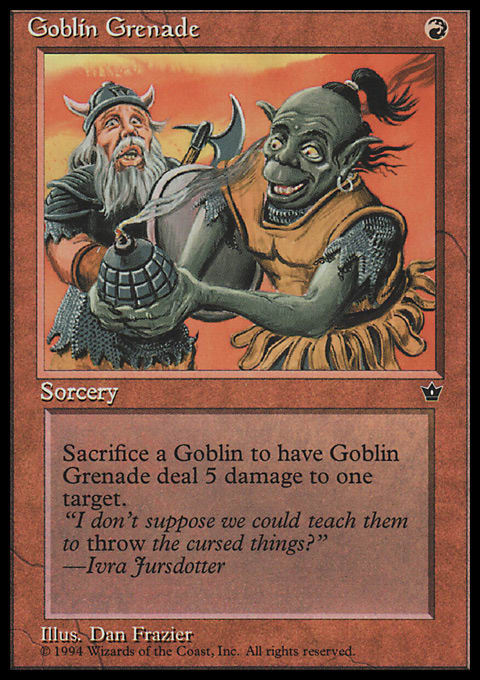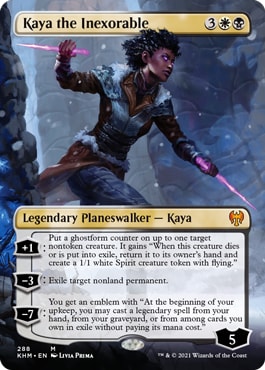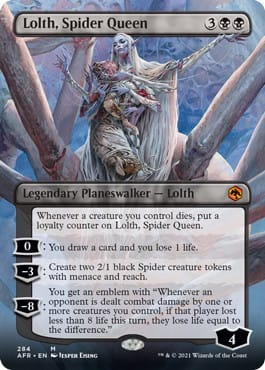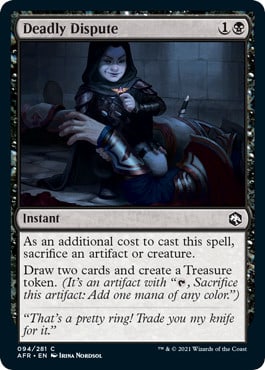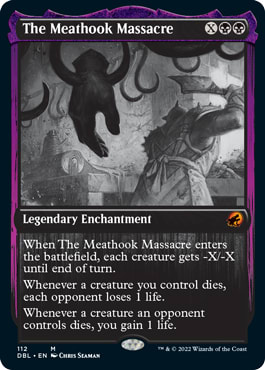Audio Version:
The Last Days of Combo Winter
It was no longer technically winter. Still, the format was no less "combo". No less Blue.
In late March there was still snow on the ground in Kansas City, and Blue was still profound in its power level. And there had never, arguably, been a greater concentration of Magic's greatest players in a single Top 8. Kansas City was the debut tournament pairing future Hall of Famer Bob Maher, Jr. with the Oath of Druids strategy he would use to win in both Chicago and Seattle a year later. With early Grand Prix success, a pre-WotC Randy Buehler was challenging Jon Finkel as the most notable American in the game; both future Hall of Famers appeared in this Top 8 with fists swinging.
All the way to the last match, Chris Pikula - the future Meddling Mage - himself with three Pro Tour Top 8s already under his belt, was the last of the elite players to fall; the last Blue mage in the format that was, in Combo Winter 1999, all about Blue.
His vanquisher?
The ultimate champion of a legendary Top 8?
Mark Gordon. The then-unknown newcomer survived not only Grand Poobah Buehler in the quarterfinals and The Great one Maher in the semis... But was among the only top finishers without a three-round bye to start the tournament. His secret?
In part, Mark blew up his own stuff.
During Combo Winter players had to contend not only with insurmountable walls of Counterspells fueled by Ophidian and plodding battlefields revolving around a turn-two Oath of Druids... But drawing their libraries on the third turn! And not in a "good" way!
While sophisticated in some sense, Magic strategy at this point biased heavily around the idea of card advantage; that little was better than getting a little bit ahead, and what would anyone ever want but a two-for-one? While Red Decks had already been established in high level play, few were hip to blowing up their own creatures... Not when saucy tools like Cursed Scroll, Fireslinger, and Hammer of Bogardan did such a nice job of removing the opponents'... Often packaged with some of that card advantage.
But Gordon proved that even against the best players, with overpowered Blue decks, even forced to play three more rounds than the established Pros, that there might be something to stealing speed by blowing up one's own Mogg Flunkies.
Long Before the Streets of New Capenna, there was already "Blood Money"
Mayhap a quarter century later, and folks were mayhap even more disheartened by what was going on in the environments around them. Pandemic lockdowns prevented - at that point - anything resembling a Grand Prix Kansas City. And in what Magic they could play, games were often un-fun due to a series of cards like, I dunno, Winota, Joiner of Forces.
It was in this overlapping hodgepodge of stuffy forces that Standard 2022 was born. A fresh, transitional, format that created breathing room for some newer cards while cleansing the Arena audience's palates of some of the bad taste "real" Standard had left in their collective mouths, Standard 2022 became an accelerated Petrie dish for new strategies, deck ideation, and innovation.
Was the Izzet Dragons deck a little too good? Probably. But I don't think it was the most interesting or persistent idea to come out of Standard 2022. That has to belong to Blood Money... A strategy - nay, a way of life - most vocally advocated by popular YouTube streamer CovertGoBlue.
Aesthetically, this deck combined the concept of A) "Blood" (from Snow payoff Blood on the Snow) and B) "Money" in the form of Treasure tokens. There were many overlapping incentives, most of which culminated in climbing from B and up to a big A.
The sexiest sequence started with this then-brand spanking Forgotten Realms 1-drop:
... And then climbing up to one of these big five-mana Planeswalkers as early as the third turn:
How did one so quickly become five?
CovertGoBlue, like Gordon those many years before, blew up his own stuff.
Made possible by Deadly Dispute, a Shambling Ghast could quickly produce not one but two Treasure tokens. If CGB were stuck on only two lands... No problem! Between the Deadly Dispute and his next draw step, he'd have three looks for land number three.
Flexibility Comes to Rakdos
Gobin Grenade taught players deck design discipline. What was being sacrificed mattered. It had to be a Goblin. You couldn't just throw this card into any deck. But in return it provided an outsized return (and decades of glory for a once-unknown Mark Gordon).
Deadly Dispute shifted resources. Cards were drawn. Mana produced. Whole strategies rose up out of its availability... Not only did one Ramp up to five for Kaya the Inexorable, but hits as disparate as Immersturm Predator and Ellywick Tumblestrum rode the vigor of CGB's Treasure / Snow engine.
With Streets of New Capenna, we gain a new way to blow up our own stuff; and in so doing, unprecedented ways to build our decks and blow up our own stuff... In order to blow up their stuff.
Thanks to the nice people in Renton, WA for letting me debut a free preview that will undoubtedly lead all of New Capenna in fatalities:
What's going on here?
For what seems like a simple card - or at least one standing on the shoulders of such straightforward grandfathers - Fatal Grudge is extraordinarily not-obvious.
Like Goblin Grenade, this is a card that requires you to build - or at least position and play - your deck a certain way in order to get value from it. Against whom is your Fatal Grudge? Do you want to kill creatures? That's easy... And probably not something that you need Fatal Grudge to accomplish in Black and Red. What about artifacts? At a minimum, you'll have to play some artifacts. And enchantments?
Woah.
That's something new.
Standard already has Rite of Oblivion. If you're, generally, in the market for blowing up your own stuff in order to blow up something specific of the opponent's... A tool already exists.
Except!
Rite of Oblivion is in White. In Black-White. For the same total mana cost in the same format, you can play Vanishing Verse. Black-White has no problems blowing up "something". What Fatal Grudge - admittedly a little more restrictive up front - provides is flexibility to Red.
It's no big deal for Plains dwellers to destroy an enchantment. White mages have been able to cast Disenchant since Alpha! But Red? Even Black-Red? Kolaghan's Command - perhaps the apex Swiss Army Knife of Black-Red removal - inherits the restrictive Disenchant / Shatter DNA of Magic's first sets.
But if your Black-Red deck wants to destroy an enchantment? Now all you have to do is play one:
Conveniently, many Black-Red decks already pack The Meathook Massacre! What's even cooler is that sacrificing a legendary permanent like this can be of diminished downside. Can you think of something more card advantageous than sweeping up the opponent's battlefield; taking a detour to excise their powerful Saga, Hallowed Haunting, or a The Meathook Massacre of their own; and then going ![]()
![]()
![]() a second time without succumbing to The Legend Rule?
a second time without succumbing to The Legend Rule?
Black-Red decks run all kinds of enchantments that can provide excellent fuel for Fatal Grudge. Just last week we talked about some of Standard's most varied and exciting Fable of the Mirror-Breaker // Reflection of Kiki-Jiki decks. Cashing in on the up-front Goblin Shaman - but taking out the opponent's key enchantment before it beats you - might just be the best destiny for a prospective Reflection of Kiki-Jiki.
The same is true for Planeswalkers. The ability to get around The Legend Rule or potentially synergize with Blood on the Snow can minimize costs for the lean, two-mana Fatal Grudge. Goodbye Kaito Shizuki. Sayonara, The Wandering Emperor.
One of the things I really like about Fatal Grudge is how it can really lean into the advantages provided by tokens. Decks that play tokens - Treasure production, or small creatures like Spiders, Samurai, or Spirits - often do so without committing "full" cards to them. A Pest Summoning is itself only a half-card (having typically come, free of draw step, from a dead Eyetwitch) but further produces two 1/1 creatures for one piece of cardboard that you never actually drew. When you pair one of these Pests with a Fatal Grudge? The central balancing of this card - asking you pay an extra permanent but paying you back with a random card from the top of your deck - goes completely out the window. It is defenestrated! Fatal Grudge's presumed balance and total cost plummets even if you're still tapping exactly two lands to cast it.
The first time you take out Edgar Markov's Coffin with a Treasure token? It's going to be glorious!
What is this card not?
Fatal Grudge is not tricky. It is not one bit elegant.
With Deadly Dispute, you're often waiting to chump the opponent's incoming Luminarch Aspirant before drawing extra cards and hoarding Treasures. You can't do that with Fatal Grudge. Whatever you're doing, you're doing at sorcery speed.
Fatal Grudge is also not easy, or obvious.
It is, however, surprisingly demanding of both commitment and setup. I think part of the reason the wise Developers in Renton, WA made this card a sorcery is that they didn't want the opponent too often with egg on their face from a bad "in response" Fatal Grudge stack sequence. While you sacrifice some angles, think about what you're getting in return! In the right spot, this card can drop a giant Hexproof creature for the cost of a Saproling! Oh, and you get to draw a card.
Fatal Grudge rewards precision, but can be a disappointing topdeck.
Back in 2015, Chris Pikula and I traveled to Utah for the Regional PTQ. I won Game 1 of my [qualifying] Top 8 matchup against a stock Esper Dragons deck with a combination of mana acceleration, permission, and judicious application of Dragonlord Dromoka.
In Game 2, the opponent kept a hand with three copies of Foul-Tongue Invocation. While that card can't "aim" per se, the concept of valuing it in general makes sense. My deck's big threats started at Dragonlord Ojutai on the low end and just got more expensive from there. "Anything" was going to be a good Edict not-target, right?
Flores brought in Omenspeaker to combat Invocation!
— Metaling Mage (@meddlingmage) April 25, 2015
The problem was when I dropped a turn-two Omenspeaker on the draw. Omenspeaker was nominally present in my sideboard to give a [relatively] big butt and a Blue mana symbol for misplaced Gerry Thompson brainchild Master of Waves. But I figured that against an opposing control deck, I would be ahead as long as I hit my land drops... So, it was there just for Scry 1!
I didn't know until I found out about Chris's Tweet how devastating this play was for the opponent. One turn two Omenspeaker was going to soak up his whole sideboarded game plan!
That is, in part, the danger of Fatal Grudge as well. While it will be amazing when applied surgically - like every time you can get a big hexproof giant, or as surprising / precision removal against unique permanent types - this card is going to be increasingly bad the more permanents of a particular type the opponent accumulates. Example: Fatal Grudge will be atrocious at killing any particular creature against a tokens deck.
But what about in Rakdos-on-Rakdos situations?
One of the most intuitive places you might want to try Fatal Grudge is Rakdos Sacrifice. Due to the appetites of Oni-Cult Anvil and The Meathook Massacre, Rakdos Sacrifice is a strategy that is already lousy with ways to put its own creatures in the graveyard; and wants to run and hide in the face of an opposing The Meathook Massacre. But in mirrors? Fatal Grudge can kind of be a mess. First of all, tons of its potential fodder are more than one thing. Constructs - whether 1/1 or 3/1 - are Artifact Creatures. The opponent now has their choice of what to sacrifice, types-wise. And they're full of garbage-y permanents, too! Drawing a card is nice. Getting a trigger (or two) if you're lucky enough to have The Meathook Massacre in play yourself. But sacrificing anything only to see the opponent bin a 1/1 Construct does not feel like a good use of two mana.
Finally, Fatal Grudge is probably not what you want to draw when you're in desperation topdeck mode. If for no other reason than you have to have the right kind of permanent to sacrifice to it in order for it to save you. Blank battlefield on blank battlefield? In the short term? Right that second? A topdecked Fatal Grudge is almost a non-card.
The one saving grace against both of these knocks? More often than not, the thing Fatal Grudge is "bad" at killing will be a creature. Which, of course, is what the rest of your color combination has been able to execute at will since 1993.
LOVE
MIKE
















